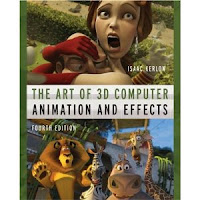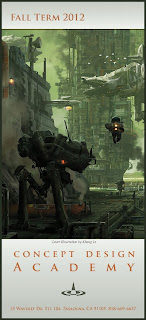Friday, November 30, 2012
Cheetah Running Slo-Mo
(Video link) A cheetah running full speed covers about 22 feet during each stride. Notice how the head stays steady as the rest of the body moves around its cycle.
(Video link) This video shows how the photographers got the shots. They built a long dolly track at the Cincinnati Zoo, with a slow motion camera following the cheetah. The trainers worked with the animal to be sure she didn't get distracted.
------
More at National Geographic
Beard and Moustache Championships
Devon Holcolme from Jacksonville, Florida is a part of Beard Team, USA. He participated in the National Beard and Moustache Championships in the Freestyle Moustache category.
Holcolme says, "You'll see everyone here likes attention. You kind of have to be silly to walk around with this."
-----
Via BYT
Previously on GJ: Best Artist's Facial Hair
Labels:
Rabbit Trails
Thursday, November 29, 2012
Grotto-eque
The word "grotesque" is related to the Italian word "grotta," a crypt or cave ornamented with fanciful forms.

It's the same Latin root where we get "grotto." The derivation traces back to the accidental discovery in the late 15th century of elaborately decorated underground rooms from the ancient Roman times. According to Wikipedia:
The "caves" were in fact rooms and corridors of the Domus Aurea, the unfinished palace complex started by Nero after the Great Fire of Rome in AD 64, which had become overgrown and buried, until they were broken into again, mostly from above. Spreading from Italian to the other European languages, the term was long used largely interchangeably with arabesque and moresque for types of decorative patterns using curving foliage elements.

It's the same Latin root where we get "grotto." The derivation traces back to the accidental discovery in the late 15th century of elaborately decorated underground rooms from the ancient Roman times. According to Wikipedia:
The "caves" were in fact rooms and corridors of the Domus Aurea, the unfinished palace complex started by Nero after the Great Fire of Rome in AD 64, which had become overgrown and buried, until they were broken into again, mostly from above. Spreading from Italian to the other European languages, the term was long used largely interchangeably with arabesque and moresque for types of decorative patterns using curving foliage elements.
Throughout the Baroque, Mannerist, and Victorian times, people built artificial grottoes (or "grotte") to stimulate the imagination.
-------
Wikipedia on "grotesque"
Wednesday, November 28, 2012
CGI Innovations at Siggraph
(Link to Video) Siggraph Asia starts today. This video gives a preview of some of the digital imaging thaumaturgy on display there.
Via BoingBoing
Labels:
Computer Graphics,
Video
Qualities of Light
We painters can learn a lot from photographers, who need to be keenly aware of the properties of light.
(Video link) In this video, Karl Taylor explains hard light, soft light, magic hour light, and reflected light.
-------
My book, Color and Light, also covers these points. You can get a copy signed by me, or from Amazon .
.
(Video link) In this video, Karl Taylor explains hard light, soft light, magic hour light, and reflected light.
-------
My book, Color and Light, also covers these points. You can get a copy signed by me, or from Amazon
Labels:
Lighting,
Photography
Tuesday, November 27, 2012
Extreme Facial Expressions
Franz Xaver Messerschmidt (1736 – 1783) was a German-Austrian sculptor known for his "character heads" – busts with extreme facial expressions.
He started out as an academically trained sculptor doing normal portrait commissions.
But then the work dried up, he lost his teaching position, and he suffered a mental malady that they called "confusion in the head."
He also suffered a stressful abdominal problem. When he pinched a rib to distract himself from the pain, he noticed that he winced in interesting ways.
He developed an interest in necromancy and the arcane, which further inspired his character heads.
Wikipedia on Franz Xaver Messerschmidt
Thanks, Frank!
Labels:
Portraits
Monday, November 26, 2012
Subterranean Prospector
Here are some pen and marker sketches for the cover of James Blaylock's 1984 science fiction novel "Digging Leviathan." Blaylock was one of the originators of the "steampunk" movement.

The fish-shaped digging machine was made from spare parts found around the house: a garbage can, a roller skate, a brace and bit, a bicycle, some shovels, and an old umbrella. The character was inspired by the "subterranean prospector" device that he read about in E. R. Burroughs' novel "At the Earth's Core."
While still in the idea generating stage, I find it helps to draw something over and over again, because each time new ideas emerge. The final cover
--------
Previously: Digging Leviathan, showing an unused color sketch.Wikipedia on "The Digging Leviathan"
Sunday, November 25, 2012
Bargue Study of a Seated Man
This little study of a seated man by Charles Bargue (1826/7-1883) has some interesting tonal decisions.

The values are carefully grouped and controlled. In the left side of the jacket, for instance, he didn't overdefine the modeling on the light side, allowing all those light tones to group together into a larger shape.
The darks are also grouped, so that the face in shadow joins at the chin with the dark shirt-front, and the knuckles link up with the blue cloth and the legs into a bigger unit.
The study is also a great example of the "windmill principle," a tonal scheme where the figure/ground relationship includes all four basic possibilities:
1. Light against dark (knee at far right and bottom of jacket)
2. Dark against light (head)
3. Dark against dark (area around hands)
4. Light against light (shoulder and back)
All this is worth mentioning because I find the automatic tendency is to break up everything into smaller and smaller shapes and to define every edge equally. In my experience, grouping shapes and downplaying certain edges takes conscious effort.
-----
Charles Bargue on Wikipedia
Bargue is known to atelier students for his excellent course for academic drawing that he developed with Jean-Léon Gérôme
Labels:
Academic Painters,
Composition
Saturday, November 24, 2012
Daumier's Cartoons on Art
Honoré Daumier (1808-1879) did a lot of cartoons satirizing art and artists. The humor is remarkably enduring, because some things don't change.


"They refused this....ignoramuses!"
"Come on... don't be such a bourgeois.... at least have a look at this Courbet!"
Influential Critic's Promenade
"This year, Venuses....again."
The Amateurs (visitors to an artist's studio)
"Well, if you look very closely, you might end up finding some quality. The color seems to be good."
Labels:
Comics/Cartooning
Friday, November 23, 2012
Retro Calculator
Schoty and his Ankylosaurus pal Soroban help merchants with their arithmetic using a giant abacus mounted on Soroban’s back. Schoty can reach out with his wooden stick to move the red beads back and forth within the wooden frame. The abacus here resembles the Chinese version, though other kinds of abacuses occur elsewhere in the world. In fact the names “Schoty” and “Soroban” are the Russian and Japanese words for “abacus.”
-----
More about retro calculators
Thursday, November 22, 2012
Cooking Eggs, Spanish Style
According to a New York Times article, chef José Andrés used a cooking technique that he found confirmed in the painting "Woman Cooking Eggs" by the 17th century master Diego Velázquez.
"He tipped a heated pan of olive oil and swirled the white as it coalesced around a gleaming yellow yolk. 'It is Velázquez, it could not be more Spanish, and it is simple, said Mr. Andrés."
Wednesday, November 21, 2012
Freewheeling imagination
Kim Jung Gi puts in another solid performance, this time with a Pentel brush pen
-----
Previously: Kim Jung Gi
Labels:
Comics/Cartooning
Tuesday, November 20, 2012
DreamWorks' Animation Resources
 DreamWorks Animation has a comprehensive in-house training program which provides a lot of resources for their artists. They provide every incoming artist with a list of the books and resources that they have found most helpful for mastering the art of animation.
DreamWorks Animation has a comprehensive in-house training program which provides a lot of resources for their artists. They provide every incoming artist with a list of the books and resources that they have found most helpful for mastering the art of animation.DreamWorks has generously allowed me to share this recommended list with you. The links take you to more information about each of the books. If the resources are not books, I've added a note about where the links will take you.
Acting and Improv
• Acting for Animators by Ed Hooks
• The Second City – Almanac of Improvisation by Anne Libera
• A Dictionary of Theatre Anthropology: The Secret Art of the Performer by Eugenio Barba
• Matthew Bain on Movement. Bain is a final layout artist at PDI/Dreamworks Animation and freelance music visualization artist/composer.) (Linked in) (Music visualization on YouTube)
Animation Books
•The Illusion of Life: Disney Animation by Frank Thomas & Ollie Johnston
• Your Career in Animation: How to Survive and Thrive by David Levy
• The Art of Shrek Forever After
• The Art of Madagascar: Escape 2 Africa
• The Art of Madagascar 3
• The Art of Kung Fu Panda 2
• The Art of Madagascar: Escape 2 Africa
• The Art of Madagascar 3
• The Art of Kung Fu Panda 2
Color and Painting
Computer Graphics and Visual FX
• Introduction to Computer Graphics by James D. Foley, et al
• Fundamentals of Computer Graphics by Peter Shirley
• Mathematics for Computer Graphics by John Vince
• CG101:A Computer Graphics Industry Reference (2nd Edition) by Terrence Masson
Figure and Gesture Drawing
Filmmaking Books
Layout & Composition Books
Animation Websites
Animation Educator's Forum
-----
Feel free to bookmark this post and share the list with others on your blog, Twitter, or Facebook
Thanks, Angela!
Labels:
Book reviews
Subscribe to:
Posts (Atom)












.jpeg)












